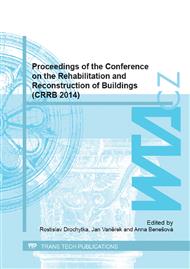[1]
Kerkhoff, Beatrix, Effects of Substances on Concrete and Guide to Protective Treatments, IS001, Portland Cement Association, (2001).
Google Scholar
[2]
Michael A., Peter C. Taylor, Rachel J. Detwiler, and Shrinivas B. Bhidé; Guide Specification for High-Performance Concrete for Bridges, EB233, 1st edition, Portland Cement Association, Skokie, Illinois, USA, (2005).
Google Scholar
[3]
Fliedner Ch., Concrete Protection with Organosilicon Compounds, ConChem Journal, No. 1 1996, H. Ziolkowsky GmbH, Augsburg, Germany, January 1996, p.3 to 8.
Google Scholar
[4]
P.V. Krivenko, S.G. Guzii, D.V. Karas, Modelling the composition of anticorrosion coating for protection of concrete structures from aggressive factors, Contemporary building materials: News of DDABA, Makiivka: DDABA, Ukraine, No1(75), 2009, pp.157-164.
Google Scholar
[5]
P.V. Krivenko, S.G. Guzii, N.A. Mokhort, D.V. Karas, Geocement compositions for protection of concrete and reinforced concrete structures from exposure of acid environments, Collection of scientific publications Building structures, Kyiv, 2010, Issue 73, pp.566-574.
Google Scholar
[6]
P.V. Krivenko, S.G. Guzii, E.S. Kavalerova, V. Petranek, Repair and protection of concrete surfaces using temperature and corrosion resistant coatings, Sbornik prispevku XXII Mezinarodni symposium Sanace 2012, Brno, 2012, pp.201-206.
Google Scholar
[7]
R.L. Lloyd, J.L. Provis, J.S.J. Deventer, Acid resistant of inorganic polymer binders, Corrosion rate, J. Materials and Structure, No 45, 2012, pp.1-4.
Google Scholar
[8]
S.G. Guzii, R. Hela, V.I. Kirichok, Rehabilitation of Concrete Surfaces of Hydropower Engineering Structures Deteriorated by Soft Corrosion and Cavitation, Advanced Materials Research, Vol. 688, 2013, pp.107-112.
DOI: 10.4028/www.scientific.net/amr.688.107
Google Scholar
[9]
P.V. Krivenko, S.G. Guzii, V.I. Kyrychok, Geocement-based Coatings for Repair and Protection of Concrete Subjected to Exposure to Ammonium Sulfate, Advanced Materials Research, Vol. 923, 2014, pp.121-124.
DOI: 10.4028/www.scientific.net/amr.923.121
Google Scholar
[10]
R.M. Barrer, D.A. Langley, Synthesis of a zeolite mineral with chabazite-like sorptive properties, J. Chem. Soc., 1958, pp.3804-3817.
Google Scholar
[11]
D.W. Breck, Zeolite Molecular Sieves: Structure, Chemistry, Wiley, 1973, 771.
Google Scholar


